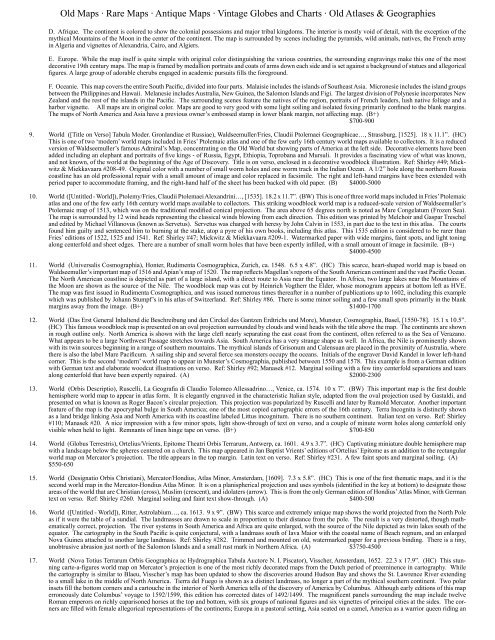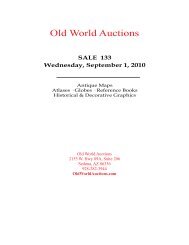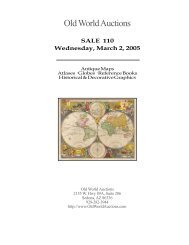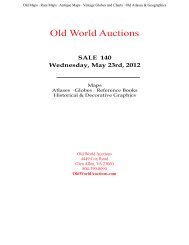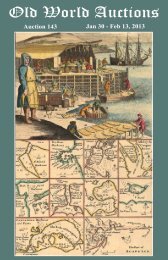PDF catalog - Old World Auctions
PDF catalog - Old World Auctions
PDF catalog - Old World Auctions
You also want an ePaper? Increase the reach of your titles
YUMPU automatically turns print PDFs into web optimized ePapers that Google loves.
<strong>Old</strong> Maps · Rare Maps · Antique Maps · Vintage Globes and Charts · <strong>Old</strong> Atlases & GeographiesD. Afrique. The continent is colored to show the colonial possessions and major tribal kingdoms. The interior is mostly void of detail, with the exception of themythical Mountains of the Moon in the center of the continent. The map is surrounded by scenes including the pyramids, wild animals, natives, the French armyin Algeria and vignettes of Alexandria, Cairo, and Algiers.E. Europe. While the map itself is quite simple with original color distinguishing the various countries, the surrounding engravings make this one of the mostdecorative 19th century maps. The map is framed by medallion portraits and coats of arms down each side and is set against a background of statues and allegoricalfigures. A large group of adorable cherubs engaged in academic pursuits fills the foreground.F. Oceanie. This map covers the entire South Pacific, divided into four parts. Malaisie includes the islands of Southeast Asia. Micronesie includes the island groupsbetween the Philippines and Hawaii. Melanesie includes Australia, New Guinea, the Salomon Islands and Figi. The largest division of Polynesie incorporates NewZealand and the rest of the islands in the Pacific. The surrounding scenes feature the natives of the region, portraits of French leaders, lush native foliage and aharbor vignette. All maps are in original color. Maps are good to very good with some light soiling and isolated foxing primarily confined to the blank margins.The maps of North America and Asia have a previous owner’s embossed stamp in lower blank margin, not affecting map. (B+)$700-9009. <strong>World</strong> ([Title on Verso] Tabula Moder. Gronlandiae et Russiae), Waldseemuller/Fries, Claudii Ptolemaei Geographicae…, Strassburg, [1525]. 18 x 11.1”. (HC)This is one of two ‘modern’ world maps included in Fries’ Ptolemaic atlas and one of the few early 16th century world maps available to collectors. It is a reducedversion of Waldseemuller’s famous Admiral’s Map, concentrating on the <strong>Old</strong> <strong>World</strong> but showing parts of America at the left side. Decorative elements have beenadded including an elephant and portraits of five kings - of Russia, Egypt, Ethiopia, Toprobana and Mursuli. It provides a fascinating view of what was known,and not known, of the world at the beginning of the Age of Discovery. Title is on verso, enclosed in a decorative woodblock illustration. Ref: Shirley #49; Mickwitz& Miekkavaara #208-49. Original color with a number of small worm holes and one worm track in the Indian Ocean. A 1/2” hole along the northern Russiacoastline has an old professional repair with a small amount of image and color replaced in facsimile. The right and left-hand margins have been extended withperiod paper to accommodate framing, and the right-hand half of the sheet has been backed with old paper. (B) $4000-500010. <strong>World</strong> ([Untitled - <strong>World</strong>]), Ptolemy/Fries, Claudii Ptolemaei Alexandrini…, [1535]. 18.2 x 11.7”. (BW) This is one of three world maps included in Fries’ Ptolemaicatlas and one of the few early 16th century world maps available to collectors. This striking woodblock world map is a reduced-scale version of Waldseemuller’sPtolemaic map of 1513, which was on the traditional modified conical projection. The area above 65 degrees north is noted as Mare Congelatum (Frozen Sea).The map is surrounded by 12 wind heads representing the classical winds blowing from each direction. This edition was printed by Melchoir and Gaspar Trescheland edited by Michael Villanovus (known as Servetus). Servetus was charged with heresy by John Calvin in 1553, in part due to the text in this atlas. The courtsfound him guilty and sentenced him to burning at the stake, atop a pyre of his own books, including this atlas. This 1535 edition is considered to be rarer thanFries’ editions of 1522, 1525 and 1541. Ref: Shirley #47; Mickwitz & Miekkavaara #209-1. Watermarked paper with wide margins, faint spots, and light toningalong centerfold and sheet edges. There are a number of small worm holes that have been expertly infilled, with a small amount of image in facsimile. (B+)$4000-450011. <strong>World</strong> (Universalis Cosmographia), Honter, Rudimenta Cosmographica, Zurich, ca. 1548. 6.5 x 4.8”. (HC) This scarce, heart-shaped world map is based onWaldseemuller’s important map of 1516 and Apian’s map of 1520. The map reflects Magellan’s reports of the South American continent and the vast Pacific Ocean.The North American coastline is depicted as part of a large island, with a direct route to Asia near the Equator. In Africa, two large lakes near the Mountains ofthe Moon are shown as the source of the Nile. The woodblock map was cut by Heinrich Vogtherr the Elder, whose monogram appears at bottom left as HVE.The map was first issued in Rudimenta Cosmographica, and was issued numerous times thereafter in a number of publications up to 1602, including this examplewhich was published by Johann Stumpf’s in his atlas of Switzerland. Ref: Shirley #86. There is some minor soiling and a few small spots primarily in the blankmargins away from the image. (B+) $1400-170012. <strong>World</strong> (Das Erst General Inhaltend die Beschreibung und den Circkel des Gantzen Erdtrichs und More), Munster, Cosmographia, Basel, [1550-78]. 15.1 x 10.5”.(HC) This famous woodblock map is presented on an oval projection surrounded by clouds and wind heads with the title above the map. The continents are shownin rough outline only. North America is shown with the large cleft nearly separating the east coast from the continent, often referred to as the Sea of Verazano.What appears to be a large Northwest Passage stretches towards Asia. South America has a very strange shape as well. In Africa, the Nile is prominently shownwith its twin sources beginning in a range of southern mountains. The mythical islands of Grisonum and Calensuan are placed in the proximity of Australia, wherethere is also the label Mare Pacificum. A sailing ship and several fierce sea monsters occupy the oceans. Initials of the engraver David Kandel in lower left-handcorner. This is the second ‘modern’ world map to appear in Munster’s Cosmographia, published between 1550 and 1578. This example is from a German editionwith German text and elaborate woodcut illustrations on verso. Ref: Shirley #92; Manasek #12. Marginal soiling with a few tiny centerfold separations and tearsalong centerfold that have been expertly repaired. (A) $2000-230013. <strong>World</strong> (Orbis Descriptio), Ruscelli, La Geografia di Claudio Tolomeo Allessadrino…, Venice, ca. 1574. 10 x 7”. (BW) This important map is the first doublehemisphere world map to appear in atlas form. It is elegantly engraved in the characteristic Italian style, adapted from the oval projection used by Gastaldi, andpresented on what is known as Roger Bacon’s circular projection. This projection was popularized by Ruscelli and later by Rumold Mercator. Another importantfeature of the map is the apocryphal bulge in South America; one of the most copied cartographic errors of the 16th century. Terra Incognita is distinctly shownas a land bridge linking Asia and North America with its coastline labeled Littus incognitum. There is no southern continent. Italian text on verso. Ref: Shirley#110; Manasek #20. A nice impression with a few minor spots, light show-through of text on verso, and a couple of minute worm holes along centerfold onlyvisible when held to light. Remnants of linen hinge tape on verso. (B+) $700-85014. <strong>World</strong> (Globus Terrestris), Ortelius/Vrients, Epitome Theatri Orbis Terrarum, Antwerp, ca. 1601. 4.9 x 3.7”. (HC) Captivating miniature double hemisphere mapwith a landscape below the spheres centered on a church. This map appeared in Jan Baptist Vrients’ editions of Ortelius’ Epitome as an addition to the rectangularworld map on Mercator’s projection. The title appears in the top margin. Latin text on verso. Ref: Shirley #231. A few faint spots and marginal soiling. (A)$550-65015. <strong>World</strong> (Designatio Orbis Christiani), Mercator/Hondius, Atlas Minor, Amsterdam, [1609]. 7.3 x 5.8”. (HC) This is one of the first thematic maps, and it is thesecond world map in the Mercator-Hondius Atlas Minor. It is on a planispherical projection and uses symbols (identified in the key at bottom) to designate thoseareas of the world that are Christian (cross), Muslim (crescent), and idolaters (arrow). This is from the only German edition of Hondius’ Atlas Minor, with Germantext on verso. Ref: Shirley #260. Marginal soiling and faint text show-through. (A) $400-50016. <strong>World</strong> ([Untitled - <strong>World</strong>]), Ritter, Astrolabium…, ca. 1613. 9 x 9”. (BW) This scarce and extremely unique map shows the world projected from the North Poleas if it were the table of a sundial. The landmasses are drawn to scale in proportion to their distance from the pole. The result is a very distorted, though mathematicallycorrect, projection. The river systems in South America and Africa are quite enlarged, with the source of the Nile depicted as twin lakes south of theequator. The cartography in the South Pacific is quite conjectural, with a landmass south of Iava Maior with the coastal name of Beach regnum, and an enlargedNova Guinea attached to another large landmass. Ref: Shirley #282. Trimmed and mounted on old, watermarked paper for a previous binding. There is a tiny,unobtrusive abrasion just north of the Salomon Islands and a small rust mark in Northern Africa. (A) $3750-450017. <strong>World</strong> (Nova Totius Terrarum Orbis Geographica ac Hydrographica Tabula Auctore N. I. Piscator), Visscher, Amsterdam, 1652. 22.3 x 17.9”. (HC) This stunningcarte-a-figures world map on Mercator’s projection is one of the most richly decorated maps from the Dutch period of preeminence in cartography. Whilethe cartography is similar to Blaeu, Visscher’s map has been updated to show the discoveries around Hudson Bay and shows the St. Lawrence River extendingto a small lake in the middle of North America. Tierra del Fuego is shown as a distinct landmass, no longer a part of the mythical southern continent. Two polarinsets fill the bottom corners and a cartouche in the interior of North America tells of the discovery of America by Columbus. Although early editions of this maperroneously date Columbus’ voyage to 1592/1599, this edition has corrected dates of 1492/1499. The magnificent panels surrounding the map include twelveRoman emperors on richly caparisoned horses at the top and bottom, with six groups of national figures and six vignettes of principal cities at the sides. The cornersare filled with female allegorical representations of the continents; Europa in a pastoral setting, Asia seated on a camel, America as a warrior queen riding an


